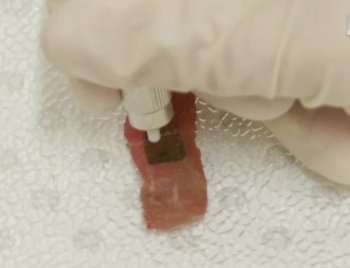New bio-adhesive polymer demonstrated in JoVE

A new video-article in JoVE, Journal of Visualized Experiments, details the use of a new laser-activated bio-adhesive polymer. The chitosan-based polymer, SurgiLux, was developed by scientists at the University of New South Wales. Chitosan is a polymer derived from chitin, which is found in fungal cell walls or in exoskeletons of crustaceans and insects.This molecular component allows SurgiLux to form low energy bonds between the polymer and the desired tissue when it absorbs light. The technology may soon replace traditional sutures in the clinic.
For thousands of years, clinicians have been using sutures to close open wounds and help repair torn tissues. Dr. L. John Foster from the University of New South Wales explains that, "though sutures have a superior strength to SurgiLux, sutures are physically invasive and do not support tissue regeneration. SurgiLux is a thin film, so you do not end up with any physical invasion or further damage to the tissue, thus allowing more complete healing." This is beneficial when repairing delicate tissues like neurons or blood vessels.
The SurgiLux polymer has two valuable properties: it can achieve a uniform seal when activated by a laser, and has antimicrobial properties attributable to the chitosan base. Together, these features prevent the wound from becoming infected and maintain a barrier between the tissue and its surroundings. A suture would require extensive bandaging to achieve the same results. The polymer is particularly useful for hard-to-operate tissues or organs, such as the eye. "We are exploring ophthalmology as a venue for SurgiLux in human patients. SurgiLux can be readily applied to the eye during surgery, and can seal the cornea in place during keratoplasty when sutures cannot," tells Dr. Foster.
Dr. Foster and his team chose to publish in JoVE to expedite adoption of the technology. While the concept of SurgiLux has been previously published, this is the first demonstration of its application with the laser. "Many surgeons want to adopt it immediately. However, people don't know how to use the lasers. JoVE can visually show that this is not a difficult system and that any group with a basic background in biochemistry can buy a laser and get to work testing SurgiLux."
More information: www.jove.com/video/3527/a-chit … al-adhesive-surgilux
















